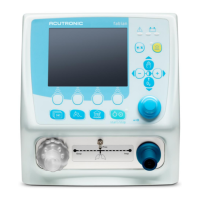Appendix A: Glossary 138
fabian +nCPAP evolution | SW V5.1.x
Ref: 122003.EN / Date : 26Jan2021
Non-Volatile Random-Access Memory.
Delivers oxygen directly into the common gas outlet without passing
through a flowmeter or vaporizer.
Post-anesthesia care Unit sometimes referred to as Post-Anesthesia
Recovery (PAR).
Patient Data Management System.
Peripheral Interface Controller.
An instrument for measuring changes in volume within an organ or
whole body (usually resulting from fluctuations in the amount of blood
or air it contains).
Proprietary brand of nasal cannula.
Transient increases in transpulmonary pressure designed to open
collapsed parts of the lung. Primarily used in Acute Respiratory Distress
Syndrome (ARDS).
The opposition to flow caused by the forces of friction. It is defined as
the ratio of driving pressure to the rate of air flow. Resistance to flow in
the airways depends on whether the flow is laminar or turbulent, on the
dimensions of the airway, and on the viscosity and density of the gas.
Rapid Shallow Breathing Index. The ratio of respiratory frequency to
tidal volume (f/VT).
Serial Peripheral Interface. A synchronous serial
communication interface specification used for short distance
communication, primarily in embedded systems.
Peripheral capillary oxygen saturation.
A surface-active lipoprotein complex (phospholipoprotein) formed by
type II alveolar cells. The proteins and lipids that make up
the surfactant have both hydrophilic and hydrophobic regions.
Used for testing Ventilator equipment.
A general direction in which something is developing or changing.
Universal Serial Bus, communication cables and connections.
Tidal Volume is the lung volume representing the normal volume of air
displaced between normal inhalation and exhalation when extra effort
is not applied.

